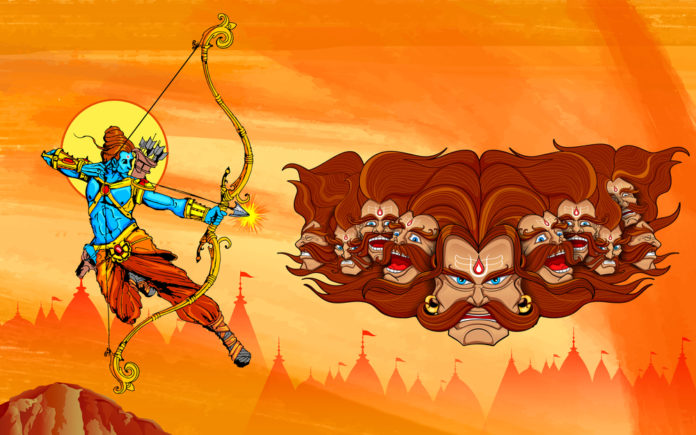This question of the authenticity of Ramayana is often debated. There have been attempts to date the text by historians and scholars in India and abroad. However, the opinions remain divided due to general consensus on the date. Moreover, lack of solid archaeological evidence (although temples, carving belonging to the period have been identified) makes it increasingly difficult to establish its legitimacy. Hence, finding out the actual era of this epic poem in the 21st century is still an enigmatic puzzle.
Whatever be polemic around its credibility, Ramayana always had a universal appeal and has charmed multitudes of people who came in contact with it. In contemporary India too, it has a considerable influence on the lives of millions. The recent re-telecast of the epic series had an average viewership of 42.6 million per episode.
Similarly, the enactment of Ramayana through Ramlila, a folk theatre tradition is very popular in North India and has survived interruptedly through many centuries (no one knows when the performance of Ramlila actually began). In 2008, UNESCO declared Ramlila as ‘Intangible Cultural Heritage of Humanity’ Besides, the colonial and post-colonial migration of Indian diaspora in European colonies in the 19th and 20th century saw Ramlila being celebrated in England, USA, Africa, Fiji, Australia, New Zealand and on the Caribbean Islands. Ramayana is also deeply rooted in South-Asian Buddhist communities where one finds its Malay, Balinese, Cambodian and Thai versions.
The dispute of proving the validity of Ramayana can be ongoing; nonetheless, there are two perspectives that can shed light on its credibility: one is the Oral Tradition and the other, Interpretation of Ramayana
Oral Tradition: the transmission of culture, beliefs, and customs in ancient India has mainly been through oral tradition. The cultural practices were preserved through the memory of the members of the society. They were never recorded or published. Colonization interrupted the oral tradition and the society saw its transition into writing while orality was limited to transcriptions of myth.
Colonial occupation in India gradually bought one homogenous western system in place. Indians began their endeavor to adapt to the new ways of foreign thinking. This undermined greatly their indigenous cultural concepts, one particularly being the way Indians viewed time.
The westerners introduced the linear concept of time. For colonizers linearity of time made life meaningful; they saw life as a continuous process just like a man’s footprint on the earth. This allowed them to have accurate records and dates of events.
The time in India was considered as cyclic, the wheel or chakra represented time. The cyclical nature involved appearance, degeneration, end of the universe, and beginning of new era. Wheel of samsara moved in a circular motion, coming back to a certain point always. The circular motion implied many repetitions to an event that was in sync with the Indic thought of rebirth where the soul comes back many times to redeem its karmas.
A vast majority of Indians, even today, believe in reincarnation. This philosophy allows infinite possibilities to return back to life as death is just a phase to transform into another form. Thus, for such a society, Rama would appear in every age; moreover, being obsessed with the temporality of the occurrence of Ramayana is nothing but absurdity.
However, the colonial dominance could not completely metamorphose the Indian psyche, for example, Hindi language which was modernized by the end of the 20th century still retains the word ‘kal’ to denote ‘tomorrow’ and ‘yesterday’. Does it mean that the attitude of timelessness is still lurking somewhere in our subconscious?.
Interpretation of Ramayana: Ramayana is an eternal classic and can be interpreted according to where one stands in their journey of life.
At a mundane level, it is just mythical adventure of humans with extraordinary powers, fantastical demons and animals, and birds who can talk.
A spiritual seeker will be able to derive more esoteric meaning by conducting an inquiry to understand the spiritual potential of Ram and his feminine energy Sita living in synchrony. The balance is disturbed by demonic tendencies of greed, arrogance, covetousness leading the world to misery, violence, and war.
Furthermore, an advance seeker might be able to deconstruct the metaphors embedded in the myth. Such a seeker would have the ability to rise over his intellectual capacity to gain yogic insights. He will be in a better position to peel the various layers of myths and reach the knowledge of non-duality in spiritual practice.
In each birth, our ability to understand Ramayana will be different depending on our intellectual capacity. Whatever level one is intellectually, the fact of being attracted to Ramayana itself will be a progressive step. Similarly, there is nothing wrong in being enamored to the mythical tale. It is not at all regressive. There will more occasions in subsequent births to advance spiritually to unfold the myth. There is no right or wrong at any point.
The story of Ramayana has the potential to unlock the limitations of living a materialistic way of life. The problem of accumulation of wealth, passion for other’s wives, losing temper, disregarding endurance, craving for power are universal and are part of every civilization. It is an excellent window for the human race to introspect into their weaknesses and find a way to live a life full of high values.
Ramayana will always have a different meaning for every individual depending on the lens he or she wears. It is a timeless, open-ended classic which will forever attract people from all walks of life to enter and experience the treasure it has to offer. Whoever makes an attempt to read, watch or hear this narrative will be transformed with a lasting impression for a lifetime. Ramayana will definitely rejuvenate and cleanse worn-out bodies and minds.
Therefore, the bottom line is the efforts of proving its authenticity is futile. However, if the legend happens to cross your path, no matter where you are on the globe, enjoy it with an understanding that best suits your temperament and allows it to heal and transform you. Jai Shri Ram!!

















How much do you charge for a Statistics Assignment Help task? Take, for my case, where I need you to provide me with the Statistics Homework Help on plotting a scatter plot with a regression line? How much should that cost? Do you charge on the basis of the workload or have a constant payment?